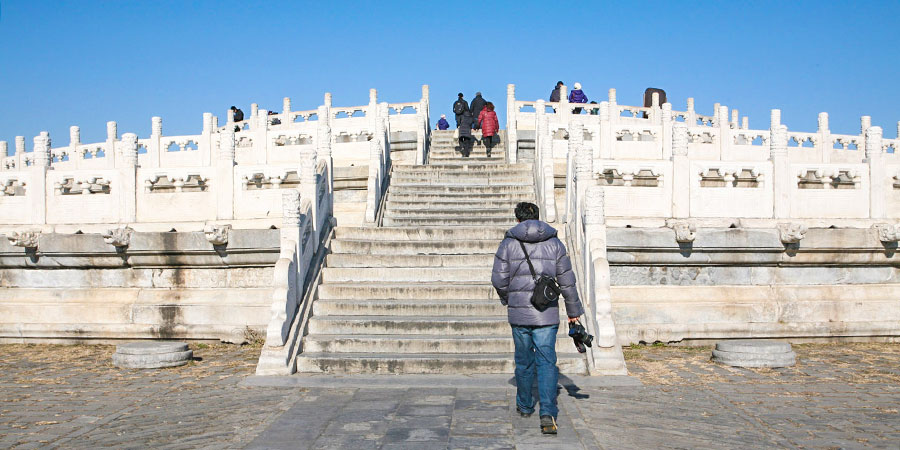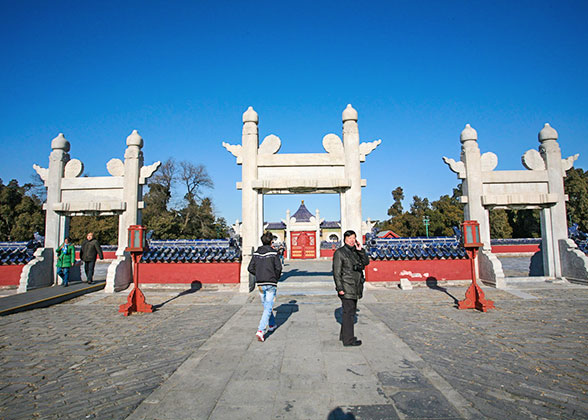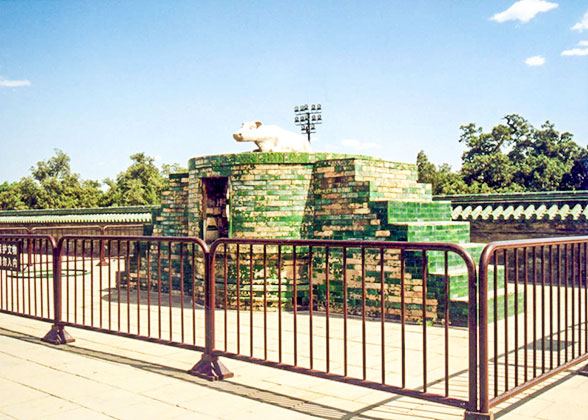The Circular Mound Altar is located to the south of the Imperial Vault of Heaven. It is an open three-layered circular stone altar. During the Ming and Qing Dynasties (1368 - 1911), the emperors would offer sacrifice to Heaven on the day of the Winter Solstice every year. This ceremony was to thank heaven and hope everything would be good in the future. Founded in the 9th year of Emperor Jiajing (1530) of the Ming Dynasty (1368 - 1644), it is the very heart of the Temple of Heaven and thus it is also known as the Terrace of Worshipping Heaven.
 |
| Circular Mound Altar |
Lingxing Gates
Entering through the Zhaoheng Gate (the southern gate), you will see a white marble road stretching out to the Circular Mound Altar. It is enclosed with two walls; the inner one is circular symbolizing heaven and the outer one is square symbolizing the earth. The two walls reflect an ancient Chinese thought that ‘heaven is round and the earth is square’. The tops of the walls are covered with green glazed tiles. 24 groups of Lingxing Gates are set around the walls. Each group includes three openings - the middle one, a special passage for the Heaven Great being the biggest; the west one for the emperor is smaller; the east one is the smallest, and is used for the accompanying personnel for the worship ceremony.
 |
| Lingxing Gate |
Lantern Viewing Pole
To the southwest of the Circular Mound Altar stands a pole which was used to hang a cylindrical bamboo-woven lantern. The pole is 29 meters (95 feet) high. It has a lever and pulley for raising and lowering the lantern. There used to be three poles, but the other two were destroyed. The Lantern Viewing Pole is not only a sign of the location of the worshipping ceremony, but also a sign of the starting time and finishing time.
Architectural Art of 9
In ancient China, odd numbers were called positive numbers, and even numbers were called negative numbers. 9 is the biggest positive number, so 9 was used to show the imperial authority. The number of fences and steps of Circular Mound Altar is either 9 or a multiple of 9. The Circular Mound Altar has three layers. The upper layer consists of fan-shaped stones, a total of 9 circles. The innermost circle has 9 stones. 9 pieces of stone were added progressively for every circle to the outside. The sum of the diameter of the three layers is 45 (9X5) Zhang (135 meters or 443 feet), symbolizing the so-called ‘Nine-Five Dignity’ of the emperor.
Heaven Heart Stone
Heaven Heart Stone, also known as Sun Stone, is one of most distinct, design-wise, in the Temple of Heaven. It is a round stone in the center of the altar which is slightly protruding. If you stand on it and shout or knock, the sound waves will be clearly echoed. In ancient times, at the Worshipping Heaven Ceremony, the ritual officer would stand on the stone to read the oration and the clangorous sound seemed to be reaching to heaven.
Firewood Stove
 |
| Firewood Stove |
The Firewood Stove is located in the southeast corner of the Circular Mound Altar. It is a huge, round and green glazed stove made from brick. There are nine stairs respectively on the east, west and south sides, reaching the top of the stove, while the north side has an opening used for adding firewood. Before the worshipping ceremony, a washed and shaved calf would be put on the stove and burned with pine twigs and reeds. After the ceremony, all the offerings, ceremonial placards and silk scrolls were respectfully put inside the stove to be burned. The ancients believed that the burning smoke could go up to heaven. To the north of the big Firewood Stove, there are eight small stoves, which were used to burn the offerings for the first eight emperors of the Qing Dynasty (1644 - 1911). East of the Firewood Stove lies a circular pool with a diameter of less than 1 meter and a depth about 30 cm, which was used to handle the fur, tail and blood of ritual sacrifices.
Divine Kitchen Courtyard
Divine Kitchen Courtyard is the general name for the Divine Kitchen, the Divine Storeroom and the Butcher Pavilion. The Divine Kitchen is a specialized kitchen that prepared more than 30 kinds of offering, such as cereals, wines, jade, silk objects and sacrificial cattle. The Divine Storeroom is where the offerings were stored. The Butcher Pavilion is a place for slaughtering ritual sacrifices.
 Next: Imperial Vault of Heaven
Next: Imperial Vault of Heaven
- Last updated on Dec. 19, 2023 by Kate Liu -



![]() Next: Imperial Vault of Heaven
Next: Imperial Vault of Heaven